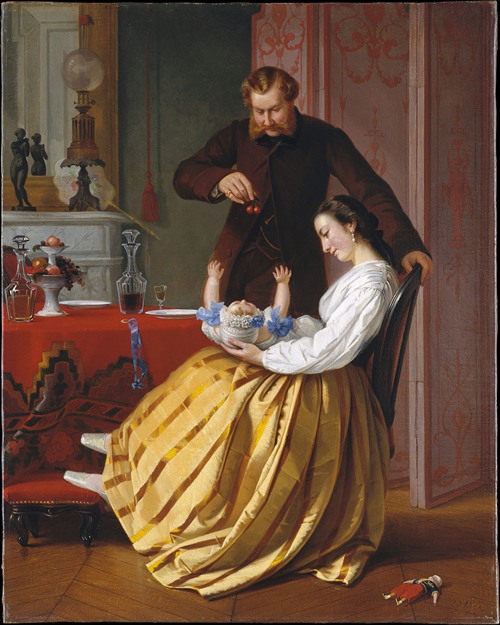


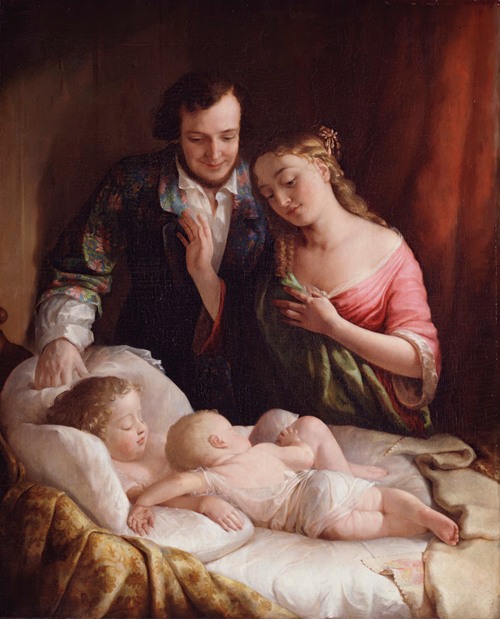
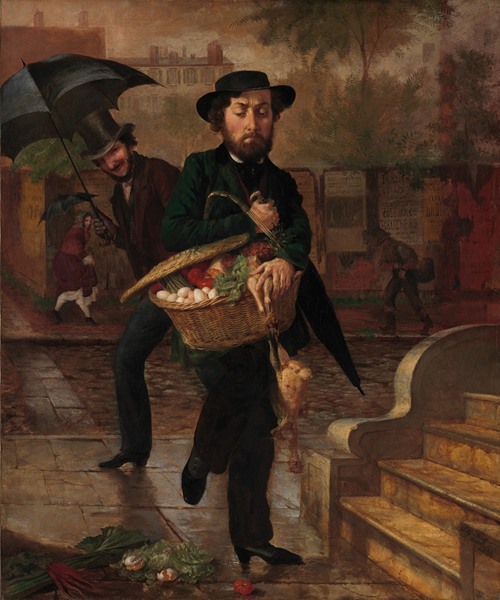
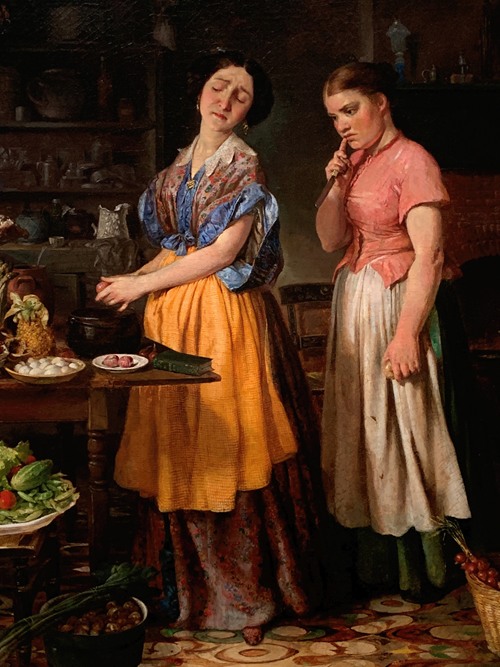
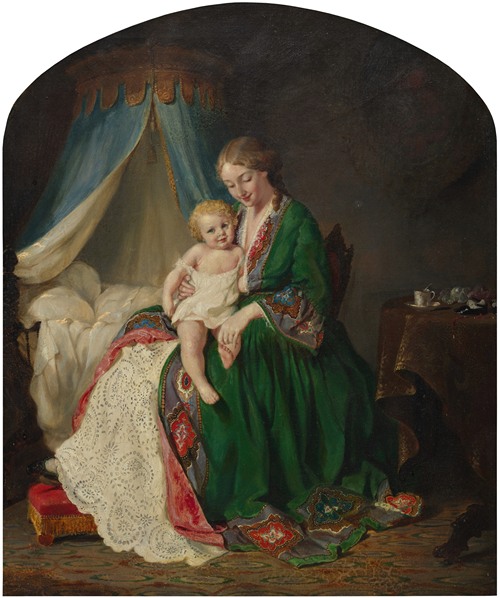
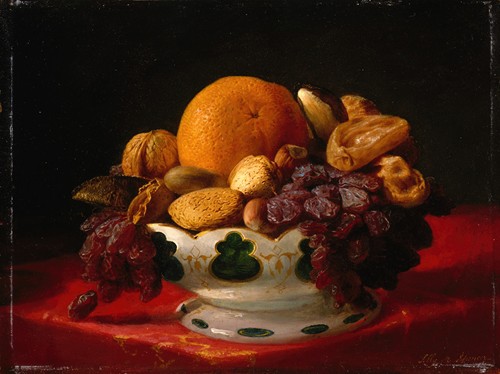

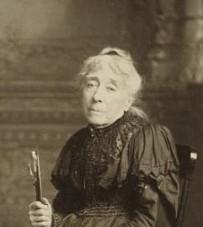

Lilly Martin Spencer was one of the most popular and widely reproduced American female genre painters in the mid-nineteenth century. She primarily painted domestic scenes, paintings of women and children in a warm happy atmosphere, although over the course of her career she would also come to paint works of varying style and subject matter, including the portraits of famous individuals such as suffragist Elizabeth Cady Stanton. Although she did have an audience for her work, Spencer had difficulties earning a living as a professional painter and faced financial trouble for much of her adult life.
Lilly Martin Spencer was born in Exeter, England to French-born parents Gilles Marie Martin and Angelique Perrine LePetit Martin. In 1830, when Lilly was eight, her family immigrated to New York where they remained for three years before ultimately moving to Marietta, Ohio. There Lilly was home-schooled by her highly educated parents and began what would be her long career as an artist. Her first artistic endeavors were “likenesses of the entire household, in lifelike, characteristic postures, so truthful as to be recognized at once by everyone who knew them." These likenesses were drawn on the walls of the family home. Rather than being scolded, Lilly was encouraged in her love of art by her parents, whose reformist tendencies—her mother was a follower of the Utopian advocate Charles Fourier—included a belief in more opportunity for women. She continued to draw and her work was so impressive that "ladies and gentlemen began to call frequently at the farm, to judge for themselves of these vaunted pictures. Their admiring comments stimulated her ambition and added to her industry; but the difficulty of procuring proper materials and the want of a competent teacher retarded her progress."
Yet she drew the attention of local artists and was mentored and helped, especially in coloring her charcoal drawings. One such mentor was Sala Bosworth, a portrait and landscape artist who trained at the Pennsylvania Academy of Fine Arts. The second was Charles Sullivan (1794–1867) who had also studied at the Pennsylvania Academy of Fine Arts; his influence is very apparent in the early work of Lilly Martin. Martin's first exhibition in August 1841 was held at a church rectory, where she drew the attention of Nicholas Longworth, a benefactor of many artists. Of Lilly Martin, Longworth said “…a new genius has sprung up at Marietta or rather within five miles of it, at a farm house in the shape of a French girl of 17 or 18 years of age. She already has painted a great number of pictures. She is entirely self taught, excels in attitudes and designs."
Though Spencer had originally traveled with her father to Cincinnati with the hopes of Longworth offering to sponsor an exhibition for Spencer, Longworth offered to help Lilly financially and discouraged her from further shows until she had more training. Longworth first made an offer to Spencer to send her to Boston for training, along with five hundred dollars. This advice she ignored; instead, she along with her father traveled to Cincinnati for an exhibition in the autumn of 1841. Cincinnati was ”swarming with artists" and Lilly would spend the next seven years studying there. This would be the most highly productive period in her career, and is marked by her move from Cincinnati to New York, and ends with her move to New Jersey. Lilly turned down Longworth's offer to send her to Europe to study; instead she received help and instruction from portrait artist James Beard and other local artists. While in Cincinnati, Spencer studied under portrait painter John Insco William. However the exact extent of her training is unknown. She produced her most well-known and popular works during the decade between 1848 and 1858. Lilly was rare in the art world. Most women used art as genteel accomplishment and not as a career. Lilly, however, provides an example of a woman who pursued art as a career.
During her third year in Cincinnati she married Benjamin Rush Spencer on August 24, 1844. Benjamin Spencer was an Englishman who worked in the tailoring business; however once they were married he no longer pursued an independent career, instead dedicating himself to helping his wife both in household chores as well as with her artistic work. This made Mrs. Spencer the main breadwinner for the family. Although the Spencers did not run a traditional home, from all accounts they had a "singularly happy one". The Spencers had thirteen children, seven of whom grew to maturity. Although many feared that matrimony would end her career as an artist, it did not; she would become the most popular and widely reproduced female genre painter of the mid-19th century.
The Spencers experienced chronic financial difficulties. In pursuit of greater opportunity they moved to New York City in 1848. There she was already known through exhibitions at the National Academy of Design and the American Art-Union. By the time the Spencers arrived in New York "art patronage was firmly in the hands of the middle class which was eager to ‘purchase’ culture, and quick to assert their preference for scenes which they could identify." Lilly Martin Spencer easily filled this gap with domestic scenes, often using her own family and pets as models. In 1849 she produced her first major successful painting, Life's Happy Hour. Scholars have noted that due to the demand of the time Spencer was "able to combine her two roles, as artist and mother with a certain degree of success." Her works were all positive and devoid of tragedy, depicting endearing scenes of domesticity; academics have commented that in this period "her paintings exude an enthusiasm and happiness reminiscent of seventeenth-century Dutch art…(and are) enhanced by a disarming gaze directly toward the viewer or his inclusion in a coy flirtation, tease, or practical joke."
Despite her positive reputation there was a disparity between Spencer’s apparent popularity and her financial success. Most of her sales were a result of art unions, and their downfall, as a result of low membership subscriptions, was a blow to her sales. She also sold possibly a million lithographs of her paintings, but of these she only received profit from the sales of the rights to the painting. She also illustrated books and magazines, such as Godey's Lady's Book and Women of the American Revolution. Again, due to the difficulty in making ends meet the Spencers moved to Newark, New Jersey in 1858. There they raised chickens and planted vegetables in order to stave off actual starvation. Spencer continued to make portraits and commissions whenever possible, and still supported her family through her art, but money remained a problem. During the late 1850s, in an attempt to expand the range of her options in domestic scenes she added sexuality to the women in her domestic spaces. This new sexuality could be due to an influx of European images, which showed women as sexual beings. This was demonstrated in more suggestive figures and elaborate hairstyles and dress.
Throughout the 1860s the Civil War changed the outlook of many artists, including Spencer. Her paintings become more thoughtful and included more patriotic themes and titles. She produced famous and perceptive works of art such as War Spirit at Home in 1866 and We Both Must Fade in 1869, which depicts a young female looking in a mirror. The title offers a view of woman in society, which applied at least during the mid-19th century, commenting on concepts of the importance of beauty of women and their role in society. It was during this time that she painted what she considered her masterpiece, Truth Unveiling Falsehood. The piece is divided in half; on one side a monstrous woman with a sheep's head is about to devour a helpless babe in its grasp, and at its feet a figure with a grossly deformed hand pays homage. On the other side a beautiful woman nurses a child. The image is divided by Truth, an angelic blond figure who lifts a cloak (Falsehood) off the monster exposing the woman-as-beast, referred to as Selfishness. The piece was not commissioned, and Spencer refused to sell it even when offered $20,000. The work, whose meaning remains ambiguous today, is her only such piece with an allegorical message.
The family moved again in the winter of 1879–80 to rural Highland, New York. Her paintings reflect this change with increased detail in landscape and farm life scenes. During the 1880s Spencer attempted to reintroduce her work to the public but found that the market had drastically altered since the Civil War. No longer was it driven by middle class mentality; instead the wealthy were steered by art dealers pushing "serious" European work. Lilly’s art dealer said, "You have not lost your old skill but in some particulars have improved on the old time things. You are broader and simpler in execution and finer in color I think," however clients were buying "the great Foreign names." Yet she continued to try and sell work only to find "her particular kind of work had outlived popular favor."
Her husband of forty-six years, Benjamin, died in February 1890, leaving Lilly a widow. She sold the farm and moved again, to a farm 10 miles away, while maintaining a studio downtown. Spencer continued to work but her financial situation remained insecure, and sometimes she was forced to pay for services with art. Lilly Martin Spencer worked until the day of her death on May 22, 1902. She had a career that spanned more than 60 years, and painted portraits of influential people of the time, such as First Lady Caroline Harrison and the suffragist Elizabeth Cady Stanton. She persevered despite financial turmoil and facing challenges that all artists must address, as well specific difficulties for a female working in a male-dominated world.








